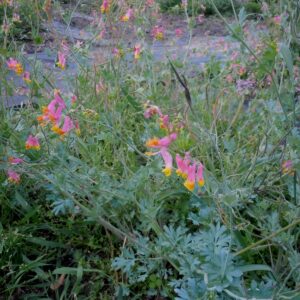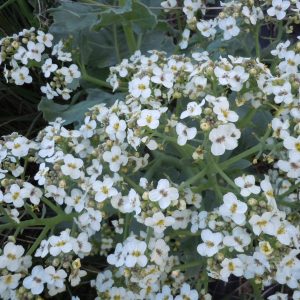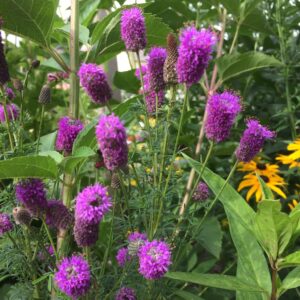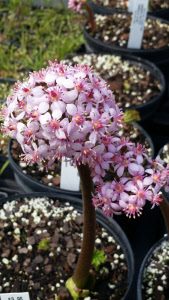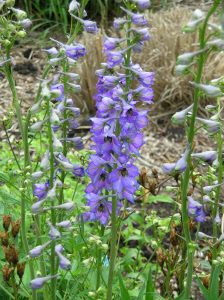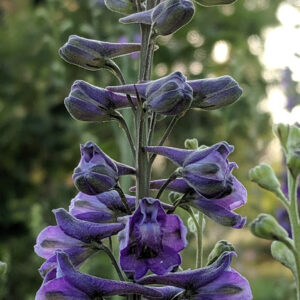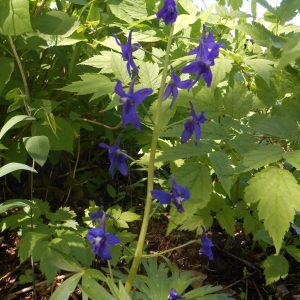Perennials & Biennials
Showing 121–128 of 485 results
-
Corydalis sempervirens syn. Capnoides sempervirens, Fumitory, Rock harlequin RESEEDING SHORT-LIVED PERENNIAL
Pink tube-shaped flowers with flaring yellow ends bloom from spring to summer
RESEEDING SHORT-LIVED PERENNIAL
Pink tube-shaped flowers with flaring yellow ends bloom from spring to summer
Size: 10-12” x 10-12”
Care: Sun to part shade in moist well drained soil
Native: from Nova Scotia west to Alaska, south to North Carolina, Wisconsin nativeCorydalis is Greek for “lark” korydalos, referring to the shape of flower resembling a lark’s spur. First described and named (name now changed) in 1753. Pressed specimen in Emily Dickinson’s herbarium.
-
Crambe maritima Sea kale Z. 5-9
Very sweetly fragrant, honey-scented, chalky white flowers cover the plant in late May and early June. Ornamental, bluish crinkled foliage all season.
Very sweetly fragrant, honey-scented, chalky white flowers cover the plant in late May and early June. Ornamental, bluish crinkled foliage all season.
Size: 18” x 12” spreads
Care: Moist well-drained soil in full sun
Native: Western Europe to Asia Minor
Awards: England’s Royal Horticultural Society Award of Merit and Great Plant Pick Award from Elisabeth Carey Miller Botanical Garden.Crambe means cabbage in Greek. “The glaucous leaves of the Sea kale afford a striking contrast to the bronzy foliage of surrounding subjects…I have eaten them several times and thought them delicious.” The Garden March 1876. “By the turn of the 19th century, sea kale was a very popular vegetable; its blanched shoots, which have a sweet, nutty cabbage flavor, were readily found in the finest markets and restaurants,” The American Gardener, March/April 2009. Grown by Jefferson. “Sea Kale was among Thomas Jefferson’s favorite vegetables; he first planted seed of it at Monticello in 1809. Native to the seacoast of Great Britain, this hardy perennial of the cabbage family is grown for the early spring sprouts that arise from well-established plants (2 to 3 years old). Sea Kale is also quite ornamental with blueish-green leaves and showy white flowers in summer. Sea Kale has a pleasing, mild cabbage taste. At Monticello the shoots are often covered with large blanching pots as they emerge in spring. When the leaves get six inches high, they are cut from the ground and can be prepared like asparagus.”. https://www.monticello.org/house-gardens/in-bloom-at-monticello/sea-kale/. Recommended as an ornamental flower by Gertrude Jekyll in 1908 for its glaucous foliage.
-
Cymbalaria muralis Kennilworth ivy, Pennywort Z 4-8
Tiny pink snapdragons all summer
Tiny pink snapdragons all summer
Size: 2-3” x spreading, trailing
Care: full sun to part shade in moist, well drained soil
Native: So. EuropeIntroduced to gardens by the early 1600’s. Southern Europeans ate the plant as a salad. Tournefort reported that it grew “on mud walls, old ruins and upon rocks” in Italy.
-
Dalea purpurea syn. Petalostemon purpurea Violet prairie clover Z 4-9
Vase shaped clump with wands of violet to purple encircling tall coneheads mid-summer
Vase shaped clump with wands of violet to purple encircling tall coneheads mid-summer
Size: 2’ x 18”
Care: full sun in well-drained to moist well-drained soil.
Native: Canada to Texas, Wisconsin native
Wildlife Value: Host for caterpillars of Dogface Sulphur, Striped blue & Mexican blue butterflies. Supports over 80 bee species including endangered Rusty patched Bumble BeesDalea named to honor English botanist Dr. Samuel Dale (1659- 1739.) Chippewa, Meskwaki and Navajo used medicinally – as remedies for heart ailments, pneumonia, diarrhea and measles. Comanche and Lakota chewed the root like gum, for its sweet taste. Sioux combined it with Amorpha canescens, Leadplant to ambush bison. Sioux also treated fevers and stomach disorders with an infusion made from the plant. Pawnee made brooms from the flexible stems. 1st collected by French botanist André Michaux (1746-1802) who spent 11 years in America collecting hundreds of new plants.
-
Darmera peltatum syn. Peltiphyllum peltatum Umbrella plant, Indian rhubarb Z 5-8
Grow this for its pink umbellifer flowers in early spring or its gigantic, round with ruffled edged foliage dramatic in green in summer but magnificent turning red in fall
Grow this for its pink umbellifer flowers in early spring or its gigantic, round with ruffled edged foliage dramatic in green in summer but magnificent turning red in fall
Size: 3-4’ x 3’
Care: shade to sun in wet soil
Native: Oregon & California
Awards: Royal Horticultural Society Award of Garden MeritCollected before 1849. Karok natives (NW corner of California) ate young shoots and Miwok tribal members, (N. central California), mixed crushed root with acorn meal to make it white.
-
Delphinium elatum Perennial larkspur Z 2-7
Spikes of blue to purple single, elf-capped shaped blossoms with black eyes in June, repeating in August-September. Sturdy stems.
OUT OF STOCK – Email for Availability
Spikes of blue to purple single, elf-capped shaped blossoms with black eyes in June, repeating in August-September. Sturdy stems. One of internationally known garden designer Piet Oudolf’s 100 “MUST HAVE” plants, Gardens Illustrated 94 (2013)
Size: 4’ x 12”
Care: part sun in moist well-drained soil.
Native: Siberia & central EuropeGrown in the Eichstätt Garden, the garden of Johann Konrad von Gemmingen, prince bishop of Eichstätt in Bavaria, c. 1600. One of the parents of today’s border hybrids. Pressed specimen in Emily Dickinson’s herbarium.
-
Delphinium exaltatum Tall Larkspur, American larkspur Z 4-8
Graceful, lavender or purple spikes of trumpets on tall stems in July to August.
Graceful, lavender or purple spikes of trumpets on tall stems in July to August.
Size: 3-4' x 9"
Care: Care: sun to part shade in moist well-drained soil. Withstands winds, no staking needed. Not fussy like fancy hybrids. Tougher and much longer living than modern hybrids. Let the seeds drop & you’ll get some babies.
Native: Pennsylvania to No. Carolina west to Ohio & Alabama
Wildlife Value: attract hummingbirdsDelphinium, named by Dioscorides, is Greek for “dolphin” due to the resemblance of the flower shape. According to Aiton, early director at Kew Royal Garden, John Bartram (1699-1777) sent it to England. London’s Chelsea Physic gardener Philip Miller grew it in 1758. Jefferson planted this at Monticello in the NW quarter of the outer border in March 1811.
-
Delphinium tricorne Dwarf larkspur, Spring larkspur Z 4-8
Spring ephemeral of blue delphinium elf-cap spikes. Substitute these for tulips, a favorite food of deer and rabbits
OUT OF STOCK – Available to order in Spring only
Spring ephemeral of blue delphinium elf-cap spikes. Substitute these for tulips, a favorite food of deer and rabbits
Size: 18-24” x 6-9”
Care: sun to shade in moist well-drained to moist soil
Native: Pennsylvania to Iowa, south to Alabama and Oklahoma and states in between
Wildlife Value: food for hummingbirds and butterflies; deer & rabbit resistant.Collected by André Michaux c. 1800. Cherokee used this for heart ailments and reported that it makes cows intoxicated and they die. The name tricorne comes from the 3-cornered shape of its seeds, like the shape of colonial hats with brims turned up on three sides. This is breathtakingly beautiful but slow to grow. It is also an ephemeral and dies back after going to seed so mark it or have a good memory where it is so you don’t dig into it planting something else. It comes back in spring.

